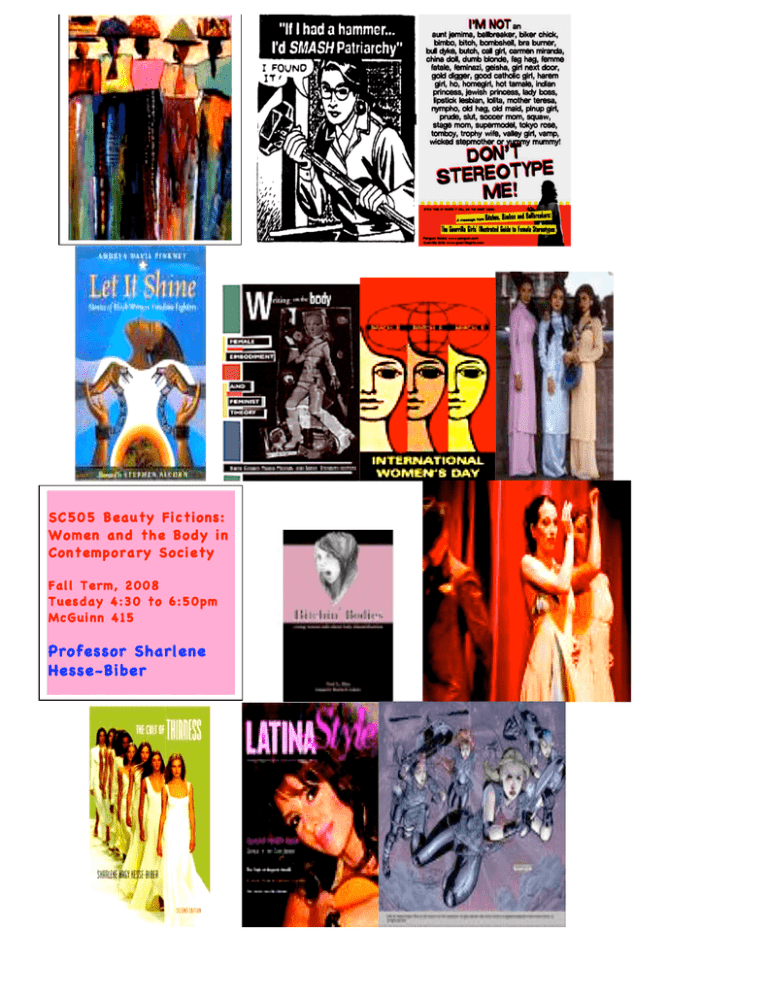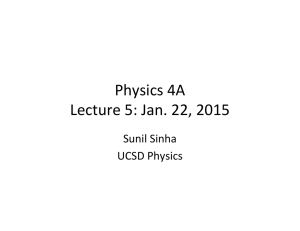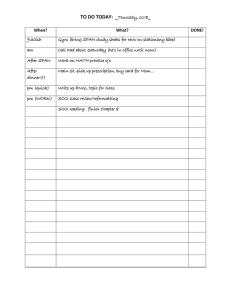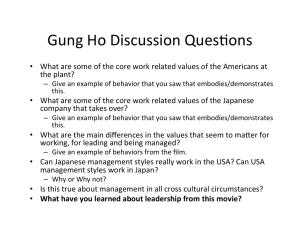Professor Sharlene Hesse-Biber SC505 Beauty Fictions:
advertisement

SC 505 Beau ty Fic tions: Wo m en an d th e Body i n Con tempo ra ry S oci ety Fall Term, 2008 Tues da y 4:30 t o 6:5 0pm McGui nn 4 15 Professor Sharlene Hesse-Biber All i ma ge s a re r e pro duc ed fro m Goo gle Ima ge s an d ar e us ed fo r e ducationa l pur pos es o nly SC505 BEA UT Y FI CTI ONS : READI NG LIST A N D CO URSE S CHED ULE STRUCTURE OF THE COURSE: Course Description. We analyze how a range of “ beauty fictions “ that serves to socially construct the female body. In particular, we examine those fictions that incorporate race and class to construct “difference” in perceptions of women’s bodies. We evaluate and critique some of the major theoretical perspectives for understanding the body. We utilize memoirs, case studies as well as cutting edge research studies that examine the embodied experiences of women as this intersects with their race, class and sexual identities. While the primary course focus is on contemporary American society, we introduce the impact of globalization and post-colonization women’s bodies in an international context. Att endance: Attendance is required. Please be on time. Turni ng i n W ork: No work will be accepted via email or in my campus mailbox, unless you make some special arrangement with me. All work needs to be handed in during the class period it is due. You will receive a half grade deduction for each day your assignment is late. Requi re d Re adings : Jane t Pric e an d Margri t Shil dric k (2003 ). F e minis t Th eory and th e B ody: A Re ade r Ne w York: Routl edge Daph ne Sch olins ki, Jane M.A dams, J ane Me re dith A dams (199 8) .The L ast Time I W ore a Dres s. N.Y.: P en gui n Book s. Sharle ne Hes se -Biber (2 007 ) Th e Cul t of Thi nnes s. Ne w York: O xf ord Universit y Pres s Maxi ne Lee ds (2002 ) Ain’ t I a Be aut y Q ue en? Blac k W ome n, B e au ty an d the P olitic s of R ace. Ox f ord Uni ve rsi ty P re ss Marya Hornbach er (1 999) W aste d: A Mem oir of A nore xi a and Bulimi a New York :H arp er B ook s. Kath y D avis : R esh api ng th e F em ale Body: The Dilemm a of Cosme tic Su rg ery 1995.R ou tle dge Rec omme nde d O nly ( St u de nt s of te n ask me for additional re adin gs th at I particul arl y like or fi n d use ful and th ose th at are ne w arri val s) Weitz, Rose (2002) The P olitics of W ome n’ s B odi es . Oxford University Press. Second Edition Rus s, T erri L. (20 08 ) Step Sist er P re ss Bi tchin' B odie s: You ng wom en t al k about body dis satis fac tion. Adkin s, D. an d B, Ske gg s (2004 ). F emini sm af t er Bou dieu . O xf ord, UK: Blac kw ell Pu blishi ng Rodrigu e z, Cl ara (20 08). He roes ,Love rs, and Oth ers: The St ory of L atin os in H ollyw ood . NY: Ox f ord Uni ve rsi ty P re ss. Plus: Additional Course Readings will be on BLACKBOARD (FORMERLY WEBCT) for this course. Cou rs e Sche dule (Som e re adin gs an d t opics are s u bjec t t o ch ange th rou gh ou t t he sem es te r—com e to class t o obt ai n u p date s) Sept em be r 2 nd : I nt roducti on and Cou rse O rg ani zati on Sept em be r 9 th Th e B ody i n Wes te rn Cul tu re : W om an as Body? Man as Min d? Ques tion: How c an we ex pl ain We st ern du alistic the ory th at eq u als woman t o body an d m an t o mi n d? Price and Shildrick, Feminist Theory and the Body, pp. 17-63, Price and Shildrick 220-26, 235-257, 275-290 Introduction: Writing on the Body: Female Embodiment and Feminist Theory (p. Edited by Conboy, Medina, Stanbury. Columbia University Press. 1-11) Sept. 16 th: The Fe mal e B ody i n the Sci en tific Discourse Price and Shildrick, Feminist Theory and the Body, pp. 157-68, 267-271, 179-202 . Ques tions: How sh oul d we the orize about th e body? Is th e body a natu ral e ntit y or a soci ally c onst ruc te d p roc es s? Wh at do w e m ean b y the se tw o w ays of thi nki ng of the b ody? Wh at is the B ody? How t o w e rec oncile th e “ph ysical b ody” wit h t he “ self ”? What doe s it me an t o be an i n divi dual ? H ow has th e discipli ne of soci ol og y the orize d t he body and wh y h as th e body bee n mostl y abs en t i n s oci ological thi nki ng ? Sept 23 rd Embodyin g ge nde r Ques tions: Bodie s are soci all y c ons truct ed th rough th e proce ss of ge nde ring—wh at it means t o be a m ale and a fe mal e. H ow does t his p roces s h appe n? What the ories s erve t o emp owe r ou r u nderst an di ng of this p roc es s? Butler, J (1993) Bodies that matter: on the discursive limits of “sex” Pp. 27-56. New York Routledge Iris Marion Young, “ Breasted Experience: The Look and the Feeling” In Rose Weitz, editor The Politics of Women’s Bodies. New York: Oxford University Press, chapter Ten Bartky,Sandra Lee (1988) "Foucault, Femininity and the Modernization of Patriarchal Power," in Feminism and Foucault: Paths of Resistance. Ed. lee Quinby and Irene Diamond. (Northeastern Univ. Press, 1988), pp. 61-86. Sept em be r 30 t h : Ch alle ngi ng Bi narie s : T rans - gen der, c ross- dre ssi ng an d ot he r t ransg ressi ons. Ques tions: How doe s t rans-g ender ch alle ng e the bi nary bet we en m ale an d f em ale g ay and st rai ght? H ow do bodies t ransg re ss the se n eat di vi des ? H ow do w e underst and th e rel ation b etw ee n our ph ysic al bodies an d ou r g e nder and se xu al iden titie s? Key Readings: Price and Shildrick, F emi nist The ory and th e B ody, 413 -31. Memoir: Daphne Scholinski, et al. The Last Time I Wore a Dress. Oct obe r 7 th : The Cl as se d Body: Soci al Cl as s and W ome n’ s B odie s. Ques tion: H ow do bodie s i n ge ne ral bec ome cl as se d? How doe s cl as s p ositi on aff ect the em bodie d e xp erie nce —h ow we sp eak, walk wh at w e we ar and how we i n ge ne ral f eel about th e body? . Bourdieu, P., (1984) Distinction: A social critique of the judgement of taste (chapter 3: ‘the habitus and the space of life-styles’). Pp, 169-225. Cambridge MA. Harvard University Press Skeggs, B (1997) Formations of class and gender: Becoming respectable. (chapter 5: ‘(dis)identifications of class’) pp, 74-97. Sage Publications, Inc. Oct obe r 14 t h : R aciali ze d Bodie s P art I. Ques tion: Wh at are th e Ke y q ues ti on s c on tai ne d i n this Secti on? hooks, b., (1992) “ Selling Hot Pussy” Weitz (Ed) The politics of women’s bodies. Oxford University Press, Second Edition. Chapter 8, Anne Fausto-Sterling, 'Gender, Race, and Nation: The Comparative Anatomy of "Hottentot" Women in Europe, 1815-1817,' pp. 19-48 in Jennifer Terry & Jacqueline Urla, Deviant Bodies: Critical Perspectives on Difference in Science and Popular Culture, Bloomington: Indiana University Press, 1995 Kaw, E., (2003) Medicalization of racial features: Asian-American women and cosmetic surgery, in Weitz, R., (Ed) The politics of women’s bodies. Chapter 12. McClintock, A (1995) Imperial leather: Race, gender and sexuality in the colonial context. Routledge. Pp. 118; Recommended: 352-390. Oct obe r 21 st : Raci ali ze d B odie s Part II Ques tion: W hat are the k ey qu esti ons contai ne d i n this sec tion? O’Connell Davidson, J (1995) British Sex Tourists in Thailand, in Maynard, M and Purvis, J (eds) (Hetero)sexual Politics. Marg aret L. H unte r, "If You ' re Li ght You' re Alrigh t" : Ligh t S kin Col or as Soci al Capi tal f or Wome n of Col or” Gender & Society, Vol. 16, No. 2, 175-193 (2002) Shilling, C., (2003) The body and social theory (pp.49-53: ‘dangerous others’). Simmonds, F. N., (1997) My body, myself: How does a Black woman do sociology?, in Mirza, H. S., (Ed), Black British feminism. Joanne Cullinane The Dom es tication of AIDS : St igma, Ge n de r, and t he Body P olitic i n Jap an. Medical Anthropology, Volume 26, Issue 3 July 2007 , pages 255 – 292 Oct obe r 28 t h : Raci alize d B odie s, Part III What are th e k e y s et of q ues tions i n t his se ction? Maxine Leeds, Ain’t I a Beauty Queen? Black Women,Beauty and the Politics of Race. Oxford University Press, 2002. Novemb er 4 t h . Hesse-Biber. The Cult of Thinness. Oxford University Press (2007) What are the key set of questions in this section? N ovem be r 11th : Reg ul ati ng an d Resi sti ng t he B ody? Bulimi a & A nore xi a an d othe r be aut y fiction s. Wh at are the ke y Que sti ons? Ke y Re adings : Jacqueline Urla and Alan C. Swedlund, 'The Anthropometry of Barbie: Unsettling Ideals of the Feminine Body in Popular Culture,' pp. 277-313 in Jennifer Terry and Jacqueline Urla, Deviant Bodies: Critical Perspectives on Difference in Science and Popular Culture , Bloomington: Indiana University Press, 1995 Marya H ornb ache r , W as te d: A Memoi r of A norexi a an d B ulimia. N ovem be r 18 t h : Th e Al te re d Body Kath y Davi s: Re sh api ng t he Fe mal e Body: Th e Dilemma of Cosme tic Surg e ry What are th ey Ke y Q ues ti on s? N ovem be r enh ancem en ts and the Cybe r- body 25th: A re bodie s re al? Techn ol og y, me dic al In thi s fi nal sec tion of the c ourse we l ook i nt o the “f u rtu ris tic” body. To wh at ex te nt can an d will tech n ol og y lit erall y t ransc e nd th e “ physical “ bou ndarie s of th e body? Wh at imp act will Cybersp ace and i ts n ew ite rati ons (i n W EB 3.0f or ex am ple ) for the w ay(s) in which the body is li nk e d t o ou r i de nti ty? Wh at are th e bou n dari es be tw ee n natu ral/s ocial an d c ybe r sp ace d b odies? Donna Haraway, 'A Cyborg Manifesto: Science, Technology, and Socialist Feminism in the Late Twentieth Century,' pp. 149-181 in Simians, Cyborgs and Women: The Reinvention of Nature NewYork:Routledge,1991 Stone, A., R., (2001) Will the real body please stand up? Boundary stories about virtual cultures, in Bell, D. and Kennedy, B (Eds) The cybercultures reader. Shilling, C., (2005) The ‘technologicalbodies’). Tues day D ecem be r 2 nd, body in culture, technology Class P re se nt ations of Re se arch Pape rs. and society (chapter 8: COURSE REQUIREMENTS Research Paper (40%) You are required to write a research paper on a specific issue that pertains to Women and the Body in Contemporary Society. I would like you to work with a research “buddy” as you progress with your paper. This buddy system is designed to motive you to keep on track with your paper. You are expected to check in with your “buddy” on the progress you have been making/not making. The Paper: Please frame a particular issue/problem that is of special interest to you that is taken in part from what you have studied in this course thus far. This is a RESEARCH paper and will thus require you to work with primary documents/materials and/or articles published in scholarly journals / documents/ scholarly research studies/books. You might also elect to do an empirical research paper and if so, you would need to specific both your research problem and specific method/s of data collection. The paper must be 15 to 20 t ype d nu mbere d p ag es , 12 pt. Font, 1 inch margins, double spaced, and typed according to APA or ASA format. You must document your work and use at least 8 to 10 documented references beyond those in our course readings. Your paper must contain an ABSTRACT along with a complete bibliography as well as any source materials (in an appendix, clearly labeled). You must send me a copy of your abstract by so that I can put together an abstract booklet for all student presentations. Pape r D eadli ne s: Oc tobe r 14 t h : P ape r O utli ne due i n cl ass. You should come up with a specific research problem/ issue. • The outline should be 1-2 typed pages – clearly explicating the problem/issue you want to address. • You must include a working bibliography and copies of three (3) articles you have relevant to your research topoic and write a short annotated summary for these 3 articles . November 3 rd You will write up a one to two page progress report, telling me specifically where you are and what remains to be done with your paper. N ovem be r 18 t h Th e Fi rs t draft of you r p ap er and abs trac t is due in class. You mu st han d in on e c op y t o you r re se arch p art ne r and h e/sh e will deliver s pecific c omm e nts t o you and a cop y t o m e no later than one week l at e r, t hat i s Novem be r 25 t h Abst ract s s houl d c on t ain th e pape r W Ti tle, auth or and no m ore than 1 50 word summ ary. You mu st al so gi ve me a cop y of you r draf t p ap er pl us abs trac t on Novem be r 18 t h as well. Fin al Du e D at e for P ap er is due D ecem be r 9 t h : Final p ap er is due cl as s for Cl ass Prese ntati on of you r work. CLASS ATTENDANCE AND CLASSROOM DISCUSSION (15%) You are expected to attend each class. One unexcused absence is given. Only under emergency circumstances (documented) will I accept an additional absence. You will lose 5% of your grade for each additional absence YOU ARE EXPECTED TO BRING A 3 X 5 CARD WITH YOU TO CLASS. Please cite TWO SPECIFIC QUOTES ( with quote, page number and article name). One quote you agreed with AND what quote you disagreed with. Be prepared to answer why you agreed/disagreed This is a seminar so that your grade is also based on how well you come to class prepared to discuss the readings—what is the quality of your contributions—what original ideas do you bring to bear on the course reading for that day? How well do you listen to the comments of others and respond to these specific comments in a thoughtful manner? How well do you listen across whatever differences you might have regarding what is being said by another? It is through our differences that we come to understand our own and other’s perspectives. THREE POSITION PAPERS (15% EACH ) You will be asked to write a total of THREE (3) position papers in this course. Each is worth 15 percent of your grade. (10 percent for the paper and 5% for how well you integrate your paper with class presentation). You are responsible for leading class discussion THREE 3 different weeks of classroom readings that you will integrate in a position paper. You should come to class prepared to discuss that week’s readings and come prepared to lead off classroom discussion on the readings for that week. BRING THREE DISCUSSION QUESTIONS WITH YOU. YOUR P ositi on PAP ER WILL BE G RAD ED O n T HE Q UALIT Y OF YO UR ESS AYS THESIS/A RGUMEN T What is your argument/thesis? Is it clearly stated? Does you argument hang together (do you support your argument with evidence?) and is not just a summary, but analytical? Here I look for WHAT evidence you bring to bear in your argument. What readings do you use (are they appropriate to this particular argument?) and how well do you use them to make an argument. Is your interpretation valid? Do you tend to go beyond the evidence such that you tend to overextend your argument? ( making over-generalizations). Is something important left out? What do you conclude and is your conclusion supported by your essay? How well written is the essay ? Is it organized? Too many quotes and not enough of the writer’s own synthesis of articles? How well is the essay formatted? References are correctly cited? The paper has been proof-read for spelling grammatical errors. The paper is correctly formatted and pages numbered?





